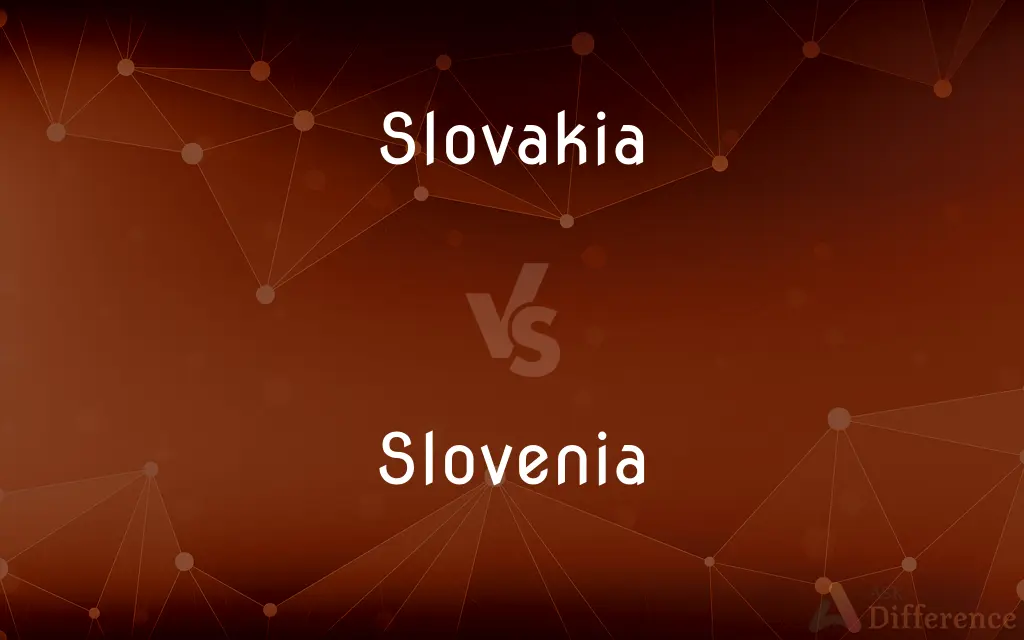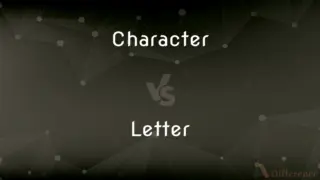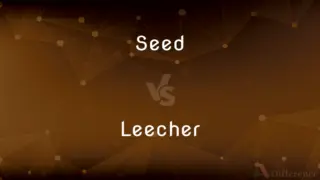Slovakia vs. Slovenia — What's the Difference?
By Urooj Arif & Fiza Rafique — Updated on April 3, 2024
Slovakia and Slovenia are two distinct Central European countries, often confused for one another, with unique languages, cultures, and histories.

Difference Between Slovakia and Slovenia
Table of Contents
ADVERTISEMENT
Key Differences
Slovakia, located in Central Europe, is known for its dramatic landscapes, castles, and a rich history that dates back to the Great Moravian Empire. While Slovenia, situated at the crossroads of Central, Southern, and Eastern Europe, boasts a diverse terrain that includes mountains, forests, and a short Adriatic coastline. This geographical distinction contributes to each country's unique natural beauty and outdoor activities.
Slovakia's capital, Bratislava, is near the Austrian border and offers a mix of medieval and modern architectural styles, reflecting its complex history under various empires and states. On the other hand, Slovenia's capital, Ljubljana, is celebrated for its green spaces and Slovenian Art Nouveau architecture, emphasizing the country's commitment to environmental sustainability.
While both countries are members of the European Union and share a Slavic heritage, their languages—Slovak and Slovene—are distinct, with different phonetic and grammatical structures. This linguistic difference highlights the diverse cultural identities within the Slavic community.
Economically, Slovakia has a strong industrial foundation, heavily influenced by its past within the Czechoslovak federation, and is a major automobile manufacturing hub in Europe. Slovenia, while also industrially developed, places a significant emphasis on tourism, banking, and services, benefiting from its scenic landscapes and strategic location.
Despite these differences, Slovakia and Slovenia share common values as EU members, including a focus on democracy, human rights, and a market economy. Both countries have transitioned successfully from communist rule to become stable, high-income economies, showcasing the resilience and adaptability of their societies.
ADVERTISEMENT
Comparison Chart
Location
Central Europe
Central, Southern, and Eastern Europe
Capital
Bratislava
Ljubljana
Language
Slovak
Slovene
Geography
Landlocked, mountains, castles
Mountains, forests, Adriatic coastline
Economy
Industrial, automobile manufacturing
Tourism, banking, services
EU Membership
Member since 2004
Member since 2004
Historical Influence
Great Moravian Empire, Hungary
Slavic, Italian, Austro-Hungarian
Population (approx.)
5.4 million
2.1 million
Currency
Euro (since 2009)
Euro (since 2007)
Compare with Definitions
Slovakia
Language.
Slovak, the official language, is a testament to the nation's Slavic heritage.
Slovenia
Language.
Slovene, rich in dialects, reflects Slovenia's complex historical influences.
Slovakia
Central European Country.
Slovakia, with its deep historical roots, is nestled in the heart of Central Europe.
Slovenia
Tourism and Services.
Slovenia capitalizes on its picturesque landscapes and strategic location to bolster its economy.
Slovakia
Rich History.
The majestic castles dotting Slovakia's landscape speak volumes of its storied past.
Slovenia
Environmental Commitment.
Ljubljana, Slovenia’s capital, was awarded the Green Capital of Europe, highlighting its environmental efforts.
Slovakia
Natural Beauty.
Slovakia's mountainous terrain offers breathtaking vistas and outdoor adventures.
Slovenia
Crossroads Location.
Slovenia lies at the intersection of diverse European cultural and geographical influences.
Slovakia
Economic Focus.
Slovakia's economy thrives on its robust automobile manufacturing industry.
Slovenia
Adriatic Coastline.
Slovenia's small but enchanting Adriatic coast is a jewel in its crown of natural wonders.
Slovakia
Slovakia ( (listen); Slovak: Slovensko [ˈslɔʋenskɔ] (listen)), officially the Slovak Republic (Slovak: Slovenská republika, listen ), is a landlocked country in Central Europe. It is bordered by Poland to the north, Ukraine to the east, Hungary to the south, Austria to the southwest, and the Czech Republic to the northwest.
Slovenia
Slovenia ( (listen) sloh-VEE-nee-ə; Slovene: Slovenija [slɔˈʋèːnija]), officially the Republic of Slovenia (Slovene: Republika Slovenija , abbr.: RS), is a country in Central Europe. It is bordered by Italy to the west, Austria to the north, Hungary to the northeast, Croatia to the southeast, and the Adriatic Sea to the southwest.
Slovakia
A landlocked republic in central Europe; separated from the Czech Republic in 1993
Slovenia
A mountainous republic in central Europe; formerly part of the Habsburg monarchy and Yugoslavia; achieved independence in 1991
Common Curiosities
What is the main difference between Slovak and Slovene languages?
The main difference lies in their phonetic, grammatical structures, and vocabulary, reflecting their distinct Slavic roots.
Are Slovakia and Slovenia part of the Balkans?
Slovakia is not considered part of the Balkans, while Slovenia is often included due to its geographical location at the northern edge of the region.
Do Slovakia and Slovenia share a border?
No, Slovakia and Slovenia do not share a border; they are separated by Austria and Hungary.
Can Slovaks and Slovenes understand each other's language?
While there may be some mutual intelligibility due to their Slavic origins, Slovaks and Slovenes cannot fully understand each other without learning the respective language.
Is there a rivalry between Slovakia and Slovenia?
There is no significant rivalry between Slovakia and Slovenia; any competition is friendly and mainly found in sports or cultural exchanges.
What unique cultural aspects define Slovenia?
Slovenia's culture is influenced by its Slavic roots and historical ties to the Mediterranean and Central Europe, evident in its architecture, cuisine, and bilingual regions.
When did Slovakia and Slovenia join the European Union?
Both Slovakia and Slovenia joined the European Union in 2004.
How do the capitals of Slovakia and Slovenia differ?
Bratislava, the capital of Slovakia, blends medieval and modern elements, while Ljubljana, Slovenia's capital, is noted for its green spaces and commitment to sustainability.
Are the economies of Slovakia and Slovenia similar?
While both have developed economies within the EU, Slovakia focuses more on industrial manufacturing, particularly automobiles, whereas Slovenia has a diversified economy with a significant emphasis on tourism, services, and banking.
What is a common misconception about Slovakia and Slovenia?
A common misconception is that they are the same country or that they share many similarities beyond their Slavic heritage and EU membership, overlooking their unique languages, cultures, and histories.
What are the visa requirements for visiting Slovakia and Slovenia?
As EU members, both countries are part of the Schengen Area, allowing free movement for EU citizens. Non-EU visitors may need a Schengen visa, depending on their nationality.
What is a traditional Slovenian dish?
A traditional Slovenian dish is potica, a rolled dough cake filled with nuts, honey, or other fillings, showcasing Slovenia's diverse culinary influences.
How do the landscapes of Slovakia and Slovenia compare?
Slovakia is known for its mountainous inland terrain and historic castles, while Slovenia offers a mix of mountains, forests, and a picturesque Adriatic coastline.
What unique cultural aspects define Slovakia?
Slovakia is renowned for its folk traditions, historic castles, and the legacy of the Great Moravian Empire, reflecting a rich cultural tapestry.
What is a traditional Slovak dish?
A traditional Slovak dish is bryndzové halušky, potato dumplings with sheep cheese and bacon, reflecting the country's hearty culinary traditions.
Share Your Discovery

Previous Comparison
Character vs. Letter
Next Comparison
Seed vs. LeecherAuthor Spotlight
Written by
Urooj ArifUrooj is a skilled content writer at Ask Difference, known for her exceptional ability to simplify complex topics into engaging and informative content. With a passion for research and a flair for clear, concise writing, she consistently delivers articles that resonate with our diverse audience.
Co-written by
Fiza RafiqueFiza Rafique is a skilled content writer at AskDifference.com, where she meticulously refines and enhances written pieces. Drawing from her vast editorial expertise, Fiza ensures clarity, accuracy, and precision in every article. Passionate about language, she continually seeks to elevate the quality of content for readers worldwide.














































